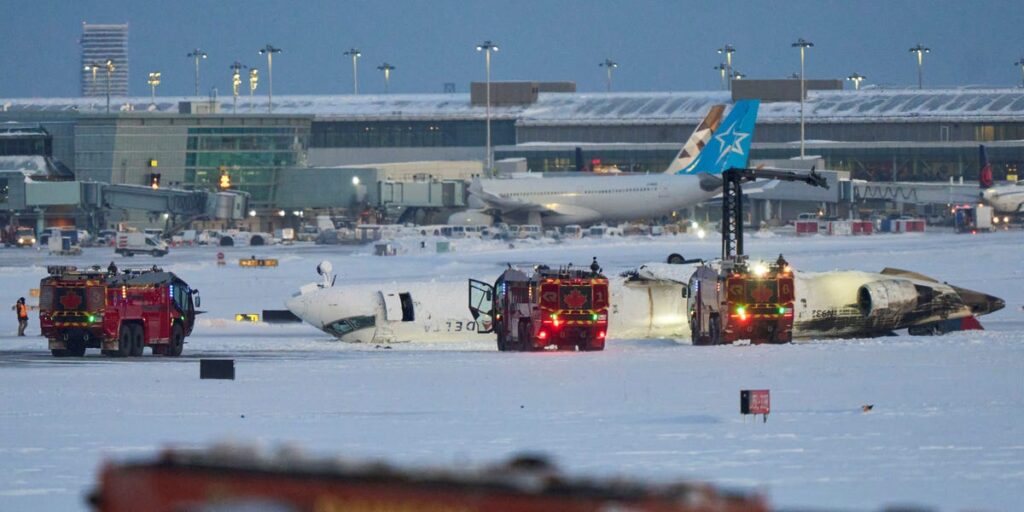- A Delta plane crash-landed and flipped upside-down in Toronto on Monday.
- Airline pilots say strong crosswinds or runway debris could have caused a landing gear failure.
- All 80 passengers and crew survived, likely thanks to aircraft design and airline safety protocols.
Three airline pilots suspect some combination of faulty landing gear, wintry weather, or debris may have caused a Delta Air Lines plane to crash and flip belly up on Monday.
Former Delta captain Mark Stephens, who flew for the carrier for 30 years, told Business Insider that video of the event shows the right main landing gear collapsing within seconds of touching down.
He said it appeared the right wing then struck the ground, detached from the jet, and caught fire. The plane then rolled and came to a rest upside-down.
“There was just no stopping this once whatever forces caused the gear to fail,” Stephens said. “The plane didn’t fully engulf in flames likely because when the wing fell off, it left the fuel behind and reduced the risk of a major spark. Snow and ice may have also helped to control the fire.”
Two other active airline pilots who asked not to be named due to the ongoing investigation and their employers’ policies regarding speaking to the media agreed that the video shows the right gear likely failing during touchdown.
Investigators have not yet given any details on what may have caused the crash.
Excessive force or debris could have hurt the landing gear
A strong crosswind and possible wind shear, a sudden change in wind direction that can affect a plane’s altitude, could have put high lateral force onto the right gear as the plane landed. The airport was reporting relatively high 33-knot gusts at the time.
Wind shear is a particular hazard during takeoff and landing that has caused plane crashes in the past.
“I’ve had some really hard landings,” Stephens said. “But I don’t think the gear would fail from a hard landing unless it had too many cycles.”
Airlines closely monitor landing gear cycles, or how many times the wheels have gone up and down, as part of their maintenance strategies. Plane manufacturers design commercial aircraft equipment to withstand heavy landings, but even these have limits, Stephens said.
Stephens, who has a background in engineering, said metal fatigue or cracking could cause a critical component of the gear to break if the fault is missed during a maintenance check.
In 2018, a Southwest Airlines plane experienced an engine failure in which one of the fan blades broke due to metal fatigue, causing fragments of the engine to escape and hit a passenger window. One person was killed.
The Delta Bombardier CRJ900 jet involved was about 16 years old but could have flown for many more years with proper maintenance and upkeep.
Stephens said debris on the runway could have been another culprit.
“If it hit an ice block, I think that could cause the gear to fail because you’re landing at 150 miles an hour,” Stephens said. “It could also be something as little as just a small piece of metal that made the tire fail.”
In 2000, an Air France Concorde jet hit a small piece of debris during takeoff, causing the tire to explode and sending fragments flying into the underside of the plane. Damage to flight control systems and a fuel tank explosion caused the plane to crash, killing 113 people.
The pilots would likely have minimal reaction time
Stephens said the plane landing in Toronto likely would have been flying in at an angle to handle the strong crosswinds. “Crabbing,” as the common technique is known, involves pointing the plane’s nose slightly into the wind to stay on course and straightening out just before landing.
Given the direction of the winds in this case, the procedure would have involved landing on the right landing gear first and keeping the right wing down into the crosswind before settling on the left main gear followed by the nose gear for a full touchdown.
“The pilots are looking straight down the runway, and they’re trained not to pull that wing out, so to me, they’re doing what they’re supposed to do,” Stephens said.
Between the landing gear failing and the wing hitting the ground, he estimates the pilots would not have time to thrust the engines to full power for a second landing attempt.
Greater Toronto Airports Authority CEO Deborah Flint said in a Tuesday press conference that the airport experienced “extreme” winter conditions over the weekend.
Monday was considered “clear,” though snow was reportedly blowing at the time of the crash.
Robust safety procedures and aircraft design helped everyone survive
Stephens said the Delta CRJ900, which was operated by the wholly-owned subsidiary Endeavor Air, is very strong and its robust airframe likely contributed to the survivability despite the damaging fire and roll.
“This is why you always wear a seatbelt and pay attention to the safety instructions,” he said.
For aircraft to be certified, US regulators require manufacturers to show everyone can evacuate in 90 seconds or less. This includes listening to crew instructions and leaving bags behind.
A Japan Airlines plane collided with another jet during landing and caught fire in January 2024. Experts said a detailed in-flight safety video paired with the passengers following crew instructions to leave bags contributed to all 379 people surviving.
Ignoring crew commands can be deadly.
In 2019, a Russian jet three times smaller than the JAL one caught fire upon landing, but people were seen evacuating with the carry-on luggage. It is believed the slowed escape caused some of the 41 people’s deaths.
Delta said on Tuesday that 19 of 21 people injured in the crash have been released from the hospital. Canada’s Transportation Safety Board is leading the investigation, with assistance from US agencies and Bombardier.
Read the full article here















